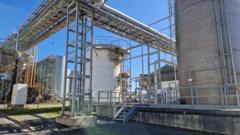Is Europe Ready to Break Free from China's Rare Earth Dominance?

Understanding the Role of Rare Earth Metals in Today's Economy
For nearly eight decades, the industrial plant in La Rochelle, located along France's picturesque west coast, has been a significant player in the global rare earth metals market. As the demand for these valuable resources surges, driven by the rapid advancement of technology, the chemical firm Solvay is expanding this facility to meet the increasing needs of Europe. Rare earth metals are essential components in a wide range of modern technologies, including smartphones, electric vehicles, wind turbines, and MRI scanners. However, about 70% of the world's rare earth mining and 90% of refining occurs in China, largely due to extensive government support over the years. This dependency on China has prompted Europe and other regions to seek ways to diversify their sources of these critical materials.
The Growing Importance of Rare Earth Metals
Rare earth metals, a group of 17 elements that includes lanthanum, cerium, and neodymium, are crucial for the manufacturing of high-tech devices. They are not only used in consumer electronics but also play a vital role in green technologies such as electric cars and renewable energy systems. With the global economy becoming increasingly reliant on these materials, the pressure is on Europe to reduce its dependency on Chinese imports. Philippe Kehren, CEO of Solvay, emphasizes that the market for rare earths is expanding rapidly, and there is a growing demand for shorter supply chains to mitigate risks associated with geopolitical tensions and natural disasters.
Europe's Strategy for Reducing Dependence on Rare Earth Imports
The European Union has recognized the urgency of addressing its reliance on rare earth imports, particularly from China. In response, the EU's Critical Raw Materials Act was enacted, setting ambitious targets for reducing import dependence by 2030. The act aims to boost the extraction, processing, and recycling of essential raw materials within Europe. Currently, Europe only has two rare earth processing facilities: one in Estonia and the other in La Rochelle, which is notably the only plant outside of China capable of processing all 17 rare earth elements.
Investment and Innovation at the La Rochelle Facility
The La Rochelle facility is undergoing significant investment to shift its focus from supplying rare earths for catalytic converters to meeting the soaring demand for magnets that are critical for electric car batteries, advanced electronics, and defense systems. As part of this transition, Solvay is prioritizing the recycling of rare earths already present in Europe. Mr. Kehren notes that they estimate they can produce up to 30% of Europe's rare earth needs by recycling end-of-life motors and other equipment.
The Challenges of Sourcing Rare Earths in Europe
Despite the steps being taken to enhance local processing capabilities, Europe currently lacks operational rare earth mines. Projects in Norway and Sweden are among the most advanced, but it may take another decade before they are operational. Mr. Kehren stresses the necessity of establishing local mining sources to complement existing processing facilities. This diversified approach will help Europe secure its supply chains and reduce vulnerability to external shocks.
The Complex Process of Rare Earth Processing
The transformation of raw rare earth materials into usable powders is a highly intricate procedure that involves approximately 1,500 distinct processes. The unique capabilities of the La Rochelle facility make it a closely guarded asset, with limited access granted to outsiders. In a recent visit, production manager Florian Gouneau provided insights into one of the plant's vital separation rooms, explaining that the goal is to purify specific rare earth elements by analogy to separating different types of fruit juices. This complex separation process is essential for ensuring the quality and purity of the final products.
The Economic and Geopolitical Implications of Rare Earth Dependency
The implications of relying on a single source for rare earth metals are significant. Benjamin Gallezot, an adviser to President Macron on strategic minerals, points out that such dependency poses risks, ranging from geopolitical tensions to potential natural disasters that can disrupt supply chains. The French government is backing the La Rochelle facility with approximately €20 million in tax credits, recognizing its strategic importance in ensuring a stable supply of rare earths within Europe.
China's Role in the Global Rare Earth Market
China's dominance in the rare earth sector stems from its willingness to manage the environmental challenges associated with mining and processing. Solvay, which also operates in China, asserts that it is possible to conduct operations responsibly without causing pollution, albeit at a higher cost. Pricing remains a critical factor for the La Rochelle plant's future operations, as securing commitments from customers in the automotive and tech industries is essential for sustainable growth.
The Future of Rare Earths in Europe
The future of the La Rochelle facility and Europe’s rare earth initiatives hinge on the successful implementation of policies aimed at reducing import dependence. Solvay hopes to see financial incentives that encourage various players in the supply chain to source rare earth elements locally. Such measures would not only bolster local economies but also enhance Europe’s strategic position in the global market for these vital resources.
FAQs About Rare Earth Metals and Their Importance
What are rare earth metals used for?
Rare earth metals are essential for manufacturing high-tech devices, including smartphones, electric vehicles, wind turbines, and medical equipment like MRI scanners. They play a crucial role in many modern technologies that require advanced materials.
Why is Europe trying to reduce its dependence on China for rare earth metals?
Europe aims to reduce its reliance on China due to geopolitical risks, supply chain vulnerabilities, and the desire to establish a more independent and sustainable sourcing strategy for critical materials.
How does recycling contribute to rare earth supply in Europe?
Recycling is expected to significantly contribute to Europe's rare earth supply by recovering materials from end-of-life electronics and motors, potentially covering up to 30% of the continent's needs without relying on new mining operations.
What are the challenges facing rare earth mining in Europe?
The main challenges include the lack of operational mines, the lengthy timeline required for new projects to become operational, and the need for regulatory and financial support to develop local sources of rare earths.
Conclusion: The Path Forward for Rare Earth Metals in Europe
The trajectory of rare earth metals in Europe is poised for transformation as the continent seeks to establish a more secure and sustainable supply chain. With the expansion of facilities like the one in La Rochelle, investments in mining projects, and a focus on recycling, Europe is taking significant steps toward reducing its dependency on Chinese imports. The question remains: how will Europe balance the need for these critical resources with environmental responsibilities and economic viability in the years to come?
As the global demand for rare earth metals continues to rise, it will be fascinating to observe how Europe navigates these challenges and opportunities. What strategies do you think will be most effective in securing a sustainable supply of rare earths in the future? #RareEarths #SustainableMining #EuropeanEconomy
Published: 2025-08-06 23:10:20 | Category: technology



